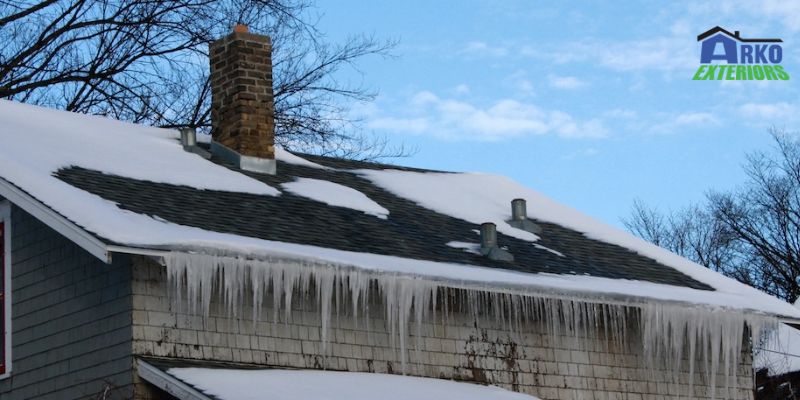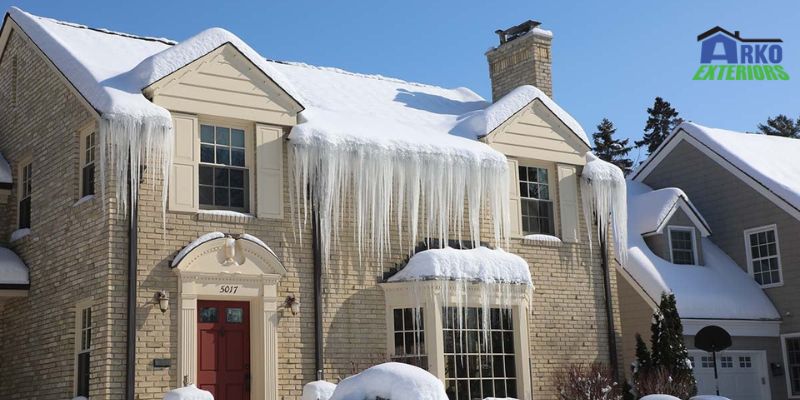Winter brings many challenges for homeowners, and one of the most damaging issues is the formation of ice dams on roofs. Ice dams occur when the snow melts on the roof, then refreezes near the roof’s edge, creating a barrier that prevents proper drainage. While it may be tempting to ignore ice dams and hope they disappear on their own, doing so can lead to significant damage and costly repairs. Ignoring ice dams can be a costly mistake!
Here’s why you don’t want to ignore ice dams…
#1 Structural Damage

One of the main reasons why ignoring ice dams is a mistake is the potential for structural damage to your home. As ice dams form, water accumulates behind them, seeping into the roof’s underlayment and potentially reaching the interior of your house. Over time, this moisture can weaken the roof structure, leading to leaks, rot and even structural instability. Repairing such damage can be an extensive and expensive process, involving roof repairs, replacing damaged materials and addressing any underlying structural issues.
#2 Interior Damage
In addition to structural damage, ignoring ice dams can result in significant interior damage to your home. As water penetrates through the roof, it can enter the attic or upper floors, causing water stains, peeling paint and damaged insulation. Prolonged exposure to moisture can also promote the growth of mold and mildew, posing health risks to you and your family. Mitigating interior damage caused by ice dams often requires not only repairing the roof but also addressing water damage, replacing affected insulation and ensuring proper ventilation to prevent future issues.
#3 Energy Efficiency
Ice dams can have a detrimental impact on your home’s energy efficiency. When warm air from the interior of your home escapes into the attic, it can melt the snow on the roof, contributing to ice dam formation. This heat loss not only wastes energy but also leads to increased heating costs. Additionally, the insulation in your attic may become compromised due to the presence of moisture, reducing its effectiveness and further impacting energy efficiency. By promptly addressing ice dams and improving insulation and ventilation, you can enhance your home’s energy efficiency and potentially save on heating expenses in the long run.
#4 Roofing System Damage

Ignoring ice dams can also lead to damage to your roofing system. As water seeps under shingles or other roofing materials, it can cause them to lift, crack or become dislodged. This compromises the integrity of the roof, making it more susceptible to leaks and further damage. Repairing or replacing damaged roofing materials can be a costly endeavor, particularly if the issue has been neglected for an extended period. Regular maintenance, prompt action and implementing preventive measures can help protect your roofing system from the detrimental effects of ice dams.
#5 Insurance Coverage Concerns
Another aspect to consider when dealing with ice dams is your insurance coverage. Neglecting ice dams and allowing damage to worsen over time may result in your insurance company denying coverage for repairs or imposing limitations on the reimbursement amount. Insurance providers typically expect homeowners to take reasonable measures to prevent damage, including addressing issues like ice dams promptly. Failing to do so can lead to disputes and out-of-pocket expenses that could have been avoided.
Summary:
Ignoring ice dams on your roof can have severe consequences, including structural damage, interior damage, reduced energy efficiency, roofing system issues and potential insurance coverage concerns. It is essential to address ice dams promptly to minimize the risk of costly repairs and ensure the safety and integrity of your home. If you notice the formation of ice dams or signs of water damage, consult with roofing professionals who can provide guidance on mitigation strategies and necessary repairs. Remember, prevention and timely action are key to protecting your home from the detrimental effects of ice dams.

